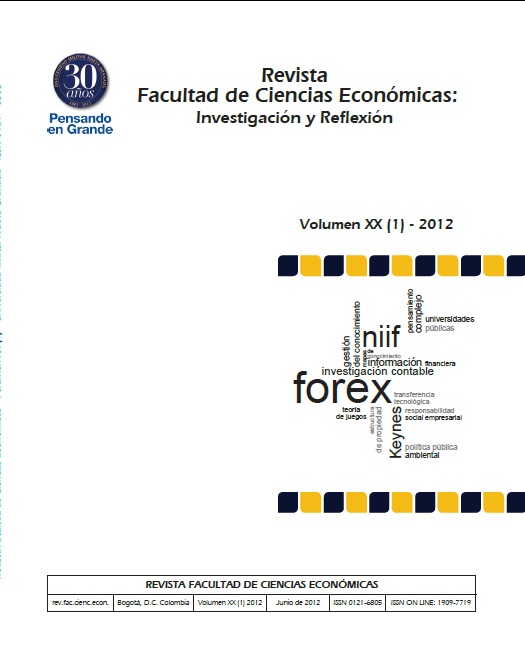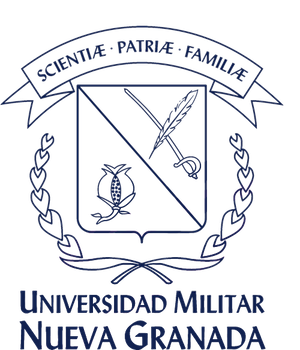Caracterização da formação da estratégia em organizações do mercado FOREX
Resumo
A presente pesquisa tem como propósito determinar as características dos enfoques estratégicos adotados pelas organizações do mercado Forex na formação da estratégia, desde a tipologia de 10 escolas da estratégia propostas por Mintzberg, Ahlstrand e Lampel (1998). Utilizaram-se como dimensões de estudo o enfoque estratégico adotado e desejado, o processo estratégico que se realiza, o conteúdo e o contexto em que se forma a estratégia. A população objeto de estudo esteve formada pelos Traders de FX (Foreign Exchange) de quarenta e dois países, incluindo a Colômbia. Dentro das principais conclusões se destaca a tendência das organizações por mudar de um enfoque estratégico baseado nas posições de mercado claramente pré-formuladas, nas seguintes direções: primeiro, para um enfoque baseado na pré-formulação, mas com simplicidade das variáveis a considerar; segundo, uma mudança de estratégia direcionada ao enfoque da aprendizagem sem a rigidez da pré-formulação; e finalmente, um enfoque que tenda às alianças com outros agentes por cima do econômico.Downloads
##plugins.generic.ArticleMetadataByBiteca.languages##:
esReferências
Andrews, K. (1971) The concept of Corporate Strategy. Homewood,IL: Irwin editions.
Ansoff, H. (1998) La dirección estratégica en la práctica empresarial. México: Pearson Educación.
Archer, M. & Bickford, J. (2007) The Forex Chartist Companion, a Visual Approach to Technical Analisys. USA: John Wiley & Sons Inc.
Argyris, C. & Shòn, D.A. (1991) Organizational learning: A Therory of Action Perspective. Reading, MA: Addison-Wesley).
Banks, E. (2005) Financial Lexicon: A Compendium of Financial Definitions, Terminology, Jargon and Slang. Palgrave Macmillan.
Barney, J. (1986) Organizational Culture: Can It Be a Source of Sustained Competitive Advantage? En: Academy of management Review: 656-665.
Barr, S., Stimpert, J. & Huff, A. (1996) Cognitive Change, Strategic Action, and Organizational Renewal. Strategic Managament Jourmal, 13: 15 - 36.
Bateson, G. (1972) Steps on Ecology of Mind. New York: Valentine Books.
Bickford, J. (2007) Charting the Major Forex Pairs. USA: Wiley Trading.
Bickford, J. (2008) Forex Wave Theory: A technical Analisys for Spot and Futures Currency Traders. USA: McGraw-Hill.
Bolman, L. & Deal, T. (1997) Reframing Organizations: Artistry, Choice and Leadershi San Francisco: Jossey-Bass Publishers.
Bower, J. & Doz, Y. (1979) Strategy Formulation: A Social and Political Process. En: D. E. Schendel & C. W. Hofer, Strategic Management. Boston: Little Brown.
Boyd, B., Gove, S. & Hitt, M. (2005) Consequences of measurement problems in strategic management research. En: Strategic Management Journal, 26 (4): 367-375.
Bracker, J. (1980) The Historical Development of the Strategic Management Concept. En: Academy of Management Review, 5: 219-224.
Bulkowski, T. (2008) Encyclopedia of Chart Patterns. New York: John Wiley & Sons, Inc.
Bulkowski, T. (2005) Encyclopedia of Candlestick Charts. New York: John Wiley & Sons, Inc.
Burrel, J. (2007) The Complete Guide to Currency Trading & Investing: How to Earn High Rates of Return Safely and Take Control of Your Investments. USA: Atlantic Publishing Group Inc.
Carrance, F. (1986) Les Outils de planification stratégique au concret. Tesis doctoral.Ecole Polytechnique, Paris.
Chandler, A. (1962) Strategy and structure: Chapters in the History of the Industrial Enterprise. USA: Cambridge, MA: MIT Press.
Corner, P, Kinicki, A. & Keats, B. (1994) Integrating Organizational and Individual Information Processing Perspectives on Choise. En: Organization Science 3: 294-308.
Creswell, J. (2005) Educational research: Planning, conducting, and evaluating quantitative and qualitative Research. Upper Saddle River: Pearson Education Inc.
Cyert, R. & March, J. (1963) A Behavioral Theory of the firm. Englewood Cliffs, Nj: Prentice Hall.
Dash, E. & Anderson, J. (2005) "How a big investor fell into Refco Deal. The New York Times.
Eagleton, C. & Williams, J. (2007) Money a History. USA: Firefly Book Ltd.
Feldman, S. (1986) Management in Context: An Essay on the Relevance of Culture in the Understanding of Organizational Change. En: Journal of Management Studies: 587 - 607.
Firsirotu, M. (1985) Strategic Turnaround as Cultural Revolution. Tesis Doctoral, McGill University, Faculty of Management, Montreal.
Feurer, R. & Chaharbaghi, K. (1995) "Strategy development: past, present and future". En: Management Decision, 33 (6): 11- 21.
Fréry, F. (2006) The Fundamental Dimensions of Strategy. En: MIT Sloan Management Review, 48 (1): 71-75.
Furrer, O., Thomas, H., & Goussevskaia, A. (2007) The structure and evolution of the strategic management field: A content analysis of 26 years of strategic management research. En: International Journal of Management Reviews, forthcoming.
Hannan, M. & Freeman J. (1977)The Population Ecology of Organizations. En: American journal of Sociology: 929-964.
Hannan, M. & Freeman, J.(1984) Structural Inertia and Organizational Change. En: American Sociological Review: 149-164.
Hamel, G. & Prahalad, C. (1994) Competing for the Future. Boston: Harvard Business School Press.
Hernández, R., Fernández-Collado, C. & Baptista, L. (2006) Metodología de la investigación. México D.F.: McGraw-Hill.
James, B. (1985) Reality and the Fight for the Market Position. En: Journal of General Managament (Spring): 45 - 57.
Jeremy, D. (2002) Business History and Strategy. En: Pettigrew, A., Thomas, H. & Whittington, R. (Comp.) Handbook of Strategy and Management: 436-460) EUA: SAGE.
Kast, F. (1970) Organizaciones y gerencia: Aproximación a un sistema. Nueva York: McGraw Hill.
Knight, K. (1967)"A Descriptive Model of the Intra-Firm Innovation Process. Chicago: Journal of Business of the University of Chicago.
Lauriol, J. (1996) Une analyse des représentations de la stratégie et de son management dans la production d'ouvrages de la langue française. France: Prepared for La Journeé Recherche of AIMS, for FNEGE.
Lien, K. (2006) Day Trading the Currency Market. USA: John Wiley Sons, Inc.
Lindblom, C. (1959) The Science of Muddling Through. En: Public Administration Review: 79-88.
Lorsch, J. (1986) Managing Culture: The invisible Barrier to Strategic Change. En: California Management Journal, 28: 95 - 109.
Macmillan, I. (1978) Strategy Formulation: Political Concepts. St. Paul: West.
Martinet, A. (1984) Management Stratégique, organisation et politique. Paris : McGraw-Hill.
Martinet, A. (1996) Pensée stratégique et rationalités: Un examen épistémologique. Lyon, France: Papier de recherché numéro 23. Institut d' Administration des Enterprises.
Martinet, A. (1997) Planification Stratégique. En: Simon, Y Joffre, P (Comps.) Encyclopédie de Gestion: 2249 - 2265. Paris: Economica, Tomo II.
Makridakis, S. (1990) Forecasting, Planning and Strategy for the 21st Century. New York: Free Press.
Miles R. & Snow, C. (1978) Organizational Strategy, Structure, and Process. New York: McGraw-Hill.
Miller, D. (1976) Strategy Making in Context: Ten Empirical Archetypes. Ph. D. thesis, Faculty of Management, Mc Gill University, Montreal.
Miller, D. (1979) Strategy, Structure, and Environment: Context Influences Upon Some Bivariate Associations. En: Journal of Management Studies: 294-316.
Miller, D. (1996) Configurations Revisited. En: Strategic Management journal: 505-512.
Miller, D. & Friesen, P. (1982)Structural Change and Performance: Quantum Versus Piece-meal-Incremental Approaches. En: Academy of Management Journal, 25 (4): 867-892.
Miller, D. & Friesen, P. (1984)Organizations: A Quantum View. Englewood Cliffs, NJ: Prentice Hall.
Miller, D. & Mintzberg, H. (1983) The Case for Configuration. In G. Morgan, Beyond Method. Beverly Hills: Sage.
Mintzberg, H. & Waters, J. (1985) Of Strategies, Deliberate, and Emergent. En: Strategic Management Journal, 6: 257-272.
Mintzberg, H. (1987) Five Ps For Strategy. California: Management Review.
Mintzberg, H. (1990) The Design School, Reconsidering the basic premises of Strategic Management. En: Strategic Management Journal, 11: 171 - 195.
Mintzberg, H. & Quinn, J. (1993) El proceso estratégico. Conceptos, contextos, casos. México: Prentice Hall Hispanoamericana S.A.
Mintzberg, H., Ahlstrand, B. & Lampel, J. (1998) Strategy Safari, A Guided Tour Through The Wilds of Strategic Management. USA: The free Press.
Nerur, S., Rasheed, A., & Natarajan, V (2008) The Intellectual Structure of the Strategic Management Field: an Author Co-citation Analysis. En: Strategic Management Journal, 29: 319-336.
Normann, R. (1977) Management for Growth. New York: Willey.
Noda, T. & Bower, J. (1996) Strategy Making as Iterated Processes of Resource Allocation. En: Strategic Management Journal, 17: 159-192.
Peters, T. & Waterman, H. (1982)In search of Excellence .New York: Harper & Row
Pettigrew, A. (1977) Strategy Formulation as a Political Process. En: International Studies of Management and Organization, 7 (2): 78-87.
Pettigrew, A. (1985) The Awakening Giant: Continuity and Change in Imperial Chemical Industries. Oxford: Basil Blackwell.
Pfeffer, J. & Salancik, G.R. (1978) The external Control of Organizations: A Resource Dependence Perspective. New York: Harper & Row.
Porter, M. (1980) Competitive Strategy: Techniques for Analyzing Industries and Competitors. New York: Free Press.
Pugh, D., Hickson, D. & Hinings, C. (1968) Dimensions of Organizational Structure. En: Administrative Science Quarterly: 65-105.
Pugh, D., Hickson, D. & Hinings, C. (1969) An Empirical Taxonomy of Structures of Work Organizations. En: Administrative Science Quarterly: 115-126.
Quinn, J. (1980) Strategies for Change: Logical Incrementalism. USA: Richard d. Irwin, Inc.
Ramos-Rodriguez, A.-R. & Ruiz-Navarro, J. (2004) Changes In The Intellectual Structure Of Strategic Management Research: A Bibliometric Study Of The Strategic Management Journal, 1980-2000. En: Strategic Management Journal, 25: 981-1004.
Ramanantsoa, B. (1997) Stratégie. En: Simon, Y. & Joffre, P. (Comp.) Encyclopédie de Gestion. ( 3026-3042) Paris: Economical, Tomo III.
Reed, J. & Bress, D. (2001) Mastering Direct Access Fundamentals. Undertanding Market Information and Lerning The Key Skills to Become a Successful Electronic Trader. USA: McGraw-Hill.
Rieger, F. (1987) The Influence of National culture on Organizational Structure, Process and Strategic Decision Making. Tesis Doctoral, McGill University, Faculty of Management, Montreal.
Ronda, G. & López, E. (2008) Empleo del Análisis de Redes Sociales para el estudio de la estructura de la relación entre definiciones del concepto estrategia elaboradas entre los años 1962 y 2003. En: Revista hispana para el análisis de redes sociales, 14(9).
Rumelt, R., Schendel, D. & Teece, D. (1994) Fundamental Issues in Strategy. A Research Agenda.Bostón: Harvard Business School Press.
Sanabria, M. (2004) Strategic organisational thinking: a diachronic perspective. En: Innovar, Universidad Nacional de Colombia, 14 (24): 59-81.
Sarrazin, J. (1977) Descentralized Planning in a Large French Company: An Interpretative Study. En: International Studies of Management and Organization: 37 - 59.
Schumpeter, J. (1947) The Creative Response in Economic history. USA: Journal of Economic History.
Selznick, P. (1957) Leadership in Administration: a Sociological Interpretation. Evanston IL: Row, Peterson.
Senge, M. (1990) The Fifth Discipline: The Art and Practice of Learning Organization. New York: Doubleday.
Simon, H. (1957) Administrative Behavior. NewYork: Mac Milan.
Smircich, L. & Stubbart, C. (1985) Strategic Management in an Enacted World. En: Academy of Management Review, 10 (4): 724 -736.
Spahn, H. (2001) From Gold to Euro: On Monetary Theory and the History of Currency Systems. Berlin: Spinger.
Sperry, R. (1974) Messages From The Laboratory. En: Engineering and Science: 29 -32.
Triennial Bank survey (2007) Triennial Central Bank survey of foreign exchange and derivatives market activity in april 2007. Bank for International Settlements, Monetary and Economic Department. Basel, Switzerland.
Tversky, A. & Kahgneman, D. (1974) Judgment Under Uncertainty: Heuristics and biases. En: Science, 185: 1124 -1131.
Van der Heijden, K. (1998) Escenarios. El arte de prevenir el futuro. Mexico: Panorama.
Von Bertalanffy, L. (1968) General System theory: Foundations, Development, Applications. New York: George Braziller
Von Newmann, J. & Morgerstern, O. (1944) Teoría de los juegos. Princeton, NJ: Princeton University Press.
Wiener, N. (1948) Cybernetics: Or Control and Communications in the Animal and the Machine. Cambridge (Mass.), M.I.T. Press.
Whittington, R. (1993) What is strategy and Does it matter? London: Routledge.
Zald, M. N. & Berger, M. A. (1978) Social Movements in Organizations: Coup d'Etat, Insurgency and Mass Movements. En: American Journal of Sociology: 187-204.












